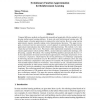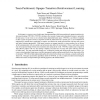119 search results - page 21 / 24 » A novel method for learning policies from constrained motion |
PAMI
2011
13 years 2 months ago
2011
— This paper proposes a novel method for recognizing faces degraded by blur using deblurring of facial images. The main issue is how to infer a Point Spread Function (PSF) repres...
CORR
2010
Springer
13 years 7 months ago
2010
Springer
Temporal difference methods are theoretically grounded and empirically effective methods for addressing reinforcement learning problems. In most real-world reinforcement learning ...
AIPS
2008
13 years 10 months ago
2008
The current evaluation functions for heuristic planning are expensive to compute. In numerous domains these functions give good guidance on the solution, so it worths the computat...
ICCV
2007
IEEE
14 years 9 months ago
2007
IEEE
In many vision problems, instead of having fully labeled training data, it is easier to obtain the input in small groups, where the data in each group is constrained to be from th...
AGENTS
1999
Springer
13 years 12 months ago
1999
Springer
In this paper, we present a novel multi-agent learning paradigm called team-partitioned, opaque-transition reinforcement learning (TPOT-RL). TPOT-RL introduces the concept of usin...


